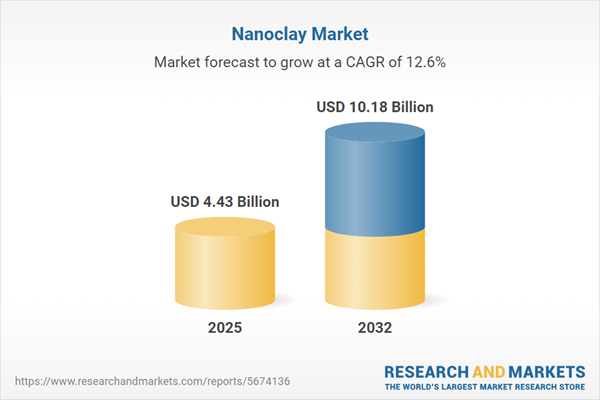Speak directly to the analyst to clarify any post sales queries you may have.
Nanoclay technologies are reshaping material innovation and sustainability strategies for manufacturers and allied industry leaders. Senior executives now view advanced nanoclay solutions as instrumental in driving operational efficiencies, enhancing compliance, and maintaining agility despite regulatory and market shifts.
Market Snapshot: Nanoclay Market Size and Outlook
The global nanoclay market commands a valuation of USD 3.93 billion, set for expansion to USD 4.43 billion by 2025 and reaching USD 10.18 billion by 2032. This growth reflects a compound annual growth rate of 12.62%. Market momentum is sustained by rising demand in sectors such as automotive, pharmaceuticals, electronics, and packaging. These industries utilize nanoclay to meet compliance mandates, achieve high product reliability, and foster greater product differentiation. For leadership teams, early engagement in nanoclay adoption supports accelerated product launches, solidifies regulatory responses, and helps sustain competitive positioning in changing global contexts.
Scope & Segmentation: Advancing Nanoclay Applications
- Application Areas: Nanoclay improves durability in automotive parts and construction materials, advances thermal management in electronic devices, and elevates barrier protection in food, pharmaceutical, and cosmetic packaging. Industrial coatings benefit from nanoclay’s support for operational efficiency and meeting sustainability objectives.
- Types of Nanoclay: Key types featured include halloysite, kaolinite, montmorillonite, organoclay, and ammonium- as well as phosphonium-based variants. Understanding performance distinctions among these types assists R&D leads and product managers in optimizing compliance and application suitability.
- End-User Industries: Sectors utilizing nanoclay include automotive manufacturing, construction, advanced packaging for food and beverages, pharmaceuticals, and electronics production. Each industry gains improved product performance, safety, and reliability from specialized nanoclay use.
- Regional Coverage: Market intelligence covers the Americas, Europe, Middle East and Africa, and Asia-Pacific. Leaders can assess opportunities by comparing mature markets like the United States and Germany with growth prospects in India, Brazil, and South Korea, informing decisions about investment and regional expansion.
- Technology Coverage: Innovations span new exfoliation methods, enhanced surface modifications, digital manufacturing integration, and strategies geared towards responsible, high-quality production. This scope enables leadership to advance operational quality while addressing external compliance demands.
- Company Coverage: Major market participants featured for benchmarking and insights into innovation trends include Imerys S.A., ALTANA AG, Clariant AG, Adeka Corporation, BASF SE, Minerals Technologies Inc., UBE Industries Ltd., Ashapura Minechem Limited, Zhejiang Fenghong Group Co., Ltd., and Gujarat Mineral Development Corporation Limited.
Key Takeaways: Strategic Nanoclay Insights for Senior Leaders
- New nanoclay processing methods foster integration with polymers, producing materials tailored for technically rigorous applications across target industries.
- Growing adoption of bio-based nanoclay supports sustainability goals, especially for construction and packaging where environmental impact is a top priority.
- Building diversified supplier networks across global regions minimizes dependency risks and enhances supply stability, addressing heightened market variability.
- Expanding research and development initiatives and diversifying product portfolios enables organizations to respond more effectively to competitive shifts and market opportunities.
- Nanoclay’s unique layered structure enables the development of lighter materials with advanced barrier properties, optimizing performance in sectors prioritizing protection and weight reduction.
- Strategic investment in elastic, regionally distributed supply chains supports adaptive sourcing and ensures regulatory-compliant operations.
Tariff Impact: Navigating Supply Chain and Trade Dynamics
Recent tariff actions in the United States affecting certain nanoclay products have prompted strategic realignment across affected regions. Companies, particularly those based in Asia, are actively exploring near-shoring, facility relocation, and longer-term supplier partnerships to mitigate cost pressures and secure operational resilience across markets influenced by these changes.
Methodology & Data Sources
This analysis draws from direct executive interviews with leading market participants, peer-reviewed research, regulatory trend evaluation, and comprehensive supply chain studies. Insights are supported by SWOT and Porter’s Five Forces tools, providing reliable support for senior-level strategic decisions regarding nanoclay.
Why This Report Matters: Executive-Ready Nanoclay Analysis
- Equips senior managers with actionable intelligence on nanoclay market drivers, enabling informed, global supply chain optimization.
- Prepares executive planners to proactively address regulatory transitions, fortifying sourcing strategies and supporting compliance frameworks.
- Offers detailed risk and innovation analysis that supports strategic navigation of evolving regulatory and geopolitical environments.
Conclusion: Strategic Leadership in Nanoclay Adoption
Leveraging advanced nanoclay solutions enhances resilience and innovation for leaders in materials-driven sectors. Targeted investment positions organizations for sustained growth and competitive advantages in an evolving global marketplace.
Additional Product Information:
- Purchase of this report includes 1 year online access with quarterly updates.
- This report can be updated on request. Please contact our Customer Experience team using the Ask a Question widget on our website.
Table of Contents
3. Executive Summary
4. Market Overview
7. Cumulative Impact of Artificial Intelligence 2025
Companies Mentioned
The companies profiled in this Nanoclay market report include:- Imerys S.A.
- ALTANA AG
- Clariant AG
- Adeka Corporation
- BASF SE
- Minerals Technologies Inc.
- UBE Industries, Ltd.
- Ashapura Minechem Limited
- Zhejiang Fenghong Group Co., Ltd.
- Gujarat Mineral Development Corporation Limited
Table Information
| Report Attribute | Details |
|---|---|
| No. of Pages | 196 |
| Published | October 2025 |
| Forecast Period | 2025 - 2032 |
| Estimated Market Value ( USD | $ 4.43 Billion |
| Forecasted Market Value ( USD | $ 10.18 Billion |
| Compound Annual Growth Rate | 12.6% |
| Regions Covered | Global |
| No. of Companies Mentioned | 11 |









